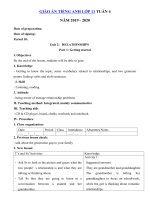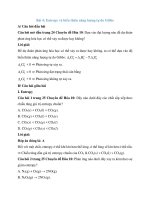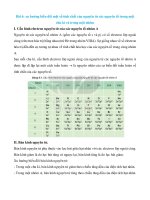giao an tieng anh lop 11 tuan 4 sach moi
Bạn đang xem bản rút gọn của tài liệu. Xem và tải ngay bản đầy đủ của tài liệu tại đây (180.34 KB, 10 trang )
VnDoc - Tải tài liệu, văn bản pháp luật, biểu mẫu miễn phí
GIÁO ÁN TIẾNG ANH LỚP 11 TUẦN 4
NĂM 2019 - 2020
Date of preparation:
Date of signing:
Period 10:
Unit 2: RELATIONSHIPS
Part 1: Getting started
I. Objectives
By the end of the lesson, students will be able to gain:
1. Knowledge
- Getting to know the topic, some vocabulary related to relationships, and two grammar
points: linking verbs and cleft sentences.
2. Skill
- Listening, reading
3. Attitude
- being aware of teenage relationship problems
II. Teaching method: Integrated, mainly communicative
III. Teaching aids
- CD & CD player, board, chalks, textbook and notebook.
IV. Procedure
1. Class organization:
Date
Period
….. __ / __ / __
Class
Attendance
Absentees/Notes
…. / ….
2. Previous lesson check:
- talk about the generation gap in your family
3. New lesson:
T’s and Ss’Activities
Knowledge
Activity 1:
Ask Ss to look at the picture and guess what the
two people' s relationship is and what they are
Suggested answers
They are grandmother and granddaughter.
VnDoc - Tải tài liệu, văn bản pháp luật, biểu mẫu miễn phí
talking or thinking about.
The
Tell Ss that they are going to listen to a
conversation
between
a
student
and
her
grandmother.
grandmother
is
telling
her
granddaughter to focus on schoolwork,
while the girl is thinking about romantic
relationships.
Play the recording. Ss listen and read the
conversation silently
Activity 2:
Ss read the statements about the conversation
T
1.
(‘oh,
and decide whether they are true, false or not
classmates’)
given.
2.
one
of
my
F (Mai tells her grandmother they'
re just friends and Nam is not her
boyfriend.)
T (*... there'
3.
s no real
friendship between a boy and a
girl.’)
T (Mai' s grandmother went
4.
to a single-sex school.)
NG
5.
6.
T (Mai tells her grandmother that
all her classmates are very kind,
Have Ss work in pairs. Ask them to read the
caring and sympathetic.)
conversation again, and find the verbs that come
before the words in the list. This activity helps Activity 3:
Ss to discover the use of linking verbs with
1.
get involved
adjectives.
2.
feel bored
3.
are very kind, caring and
sympathetic
sounds good
4. Consolidation:
- Summarize the main points: Getting to know the topic, some vocabulary related to
relationships, and two grammar points: linking verbs and cleft sentences
VnDoc - Tải tài liệu, văn bản pháp luật, biểu mẫu miễn phí
5. Homework:
- practice the tasks.
- prepare for the next lesson
--------------------------------------------------o0o-------------------------------------------------Date of preparation:
Date of signing:
Period 11:
Unit 2: RELATIONSHIPS
Part 2: Language
I. Objectives
By the end of the lesson, students will be able to gain:
1. Knowledge
- Vocabulary related to relationships, Linking verbs and Cleft sentences, contracted forms of
nouns/ pronouns
2. Skill
- Listening, reading, writing
3. Attitude
- being aware of teenage relationship problems
II. Teaching method: Integrated, mainly communicative
III. Teaching aids
- CD & CD player, board, chalks, textbook and notebook.
IV. Procedure
1. Class organization:
Date
Period
….. __ / __ / __
Class
Attendance
Absentees/Notes
…. / ….
2. Previous lesson check:
- act out the dialogue
3. New lesson:
T’s and Ss’Activities
Knowledge
I. Vocabulary:
Activity 1
VnDoc - Tải tài liệu, văn bản pháp luật, biểu mẫu miễn phí
- Ask Ss to match the words or phrases with
their meanings.
Key
1. have got a date
2. break up
3. romantic relationship 4. argument
5. sympathetic
6. lend an ear
7. be in a relationship
8. be reconciled
Activity 2
- Ask Ss to pay attention to the context in
1.
lend an ear, broke up
which the words or phrases in 1 can be used.
2.
reconciled
When using a verb or a noun, Ss need to
3.
romantic relationship
consider its suitable form (tense of verbs;
4.
in a relationship, arguments
singular or plural form of nouns).
5.
have got a date
6.
sympathetic
II. Pronunciation
Activity 1
- contracted forms in casual speech. Ask Ss to
+ shouldn' t - should not
find the shortened forms of verbs and
+you' re - you are
negative words (‘not’) and write their full
+we' re - we are
forms in the space provided.
+It' s - It is
+there' s - there is
+don' t - do not
+he' s - he is
+you' ll - you will
+Didn' t - Did not
+I' m-I am
Activity 2
- Ask Ss to listen and underline the contractions
1. will, I' ll
or the full forms in the exchanges. Explain
2. am
some of the rules for contracted forms.
3. He is, he' s
Check answers as a class.
4. we are, didn' t
Notes
a.
Noun / pronoun, etc. + verbs
VnDoc - Tải tài liệu, văn bản pháp luật, biểu mẫu miễn phí
- The short form ' s(=is/has) can be used after
nouns, pronouns, question words, here and
there. The short forms' d (= had/would), ' ll
and ' re are usually used after pronouns, some
question words, short nouns, and there.
- Full forms are used at the end of a clause
(e.g. Yes, he is.) or when the speaker wants to
emphasise
some
information,
hence
the
primary stress on the full form (e.g. He HAS
done it, not WILL do it.).
b.
-
Verbs + not
There are two possible contractions for
negative expressions, e.g. She' s not... /She isn'
t...
Negative contractions can be used at the end of
a clause, e.g. No, they haven' t
Play the recording for Ss to repeat chorally and
individually
III. Grammar
Linking verbs
Explain to Ss that linking verbs are used to
describe or identify the subjects of the verbs. Activity 1
An adjective or a noun can follow a linking 1. sounds
2. grow/get
verb, but the focus of the lesson is on the use 3. stay
4. getting
of linking verbs with adjectives.
6. look
5 seem
• First, have Ss choose a suitable verb for each
sentence from the word box, and then ask
them to use the correct form of the verb to
complete the sentence.
Activity 2
Ask Ss to read the sentences carefully and 1. unhappy
identify the linking verbs.
3. suddenly
2 warmly
4. excited
VnDoc - Tải tài liệu, văn bản pháp luật, biểu mẫu miễn phí
• Explain to them that some verbs (appear, look, 5. angry
6. annoyed
taste, smell, sound, and feel) can refer to an 7. awful
8. quickly
action (= action verbs) and be followed by an
adverb.
Cleft sentences with It is / was ...that...
Activity 3
Explain to Ss that cleft structures are used to
1.
It was her sad story that made me cry.
2.
It is you who are to blame for the damage. /
emphasise a particular part of a sentence.
It is... is used when the main verb is in the
It' s you that is to blame for the damage.
3.
present tense, and It was... is used when the
main verb is in the past tense.
s hiking in the forest that we really
enjoy.
4.
• Ask Ss to put the underlined part (= the focus)
in each sentence after It is/was...
It'
It' s your parents that / who you should
really speak to when you have problems.
5.
It' s his dishonesty that I dislike the most.
6.
It' s Jim that / who Lana is in a relationship
with.
7.
It was at the age of 20 that he became
successful as a famous writer.
8.
It was in a nice coffee shop that they had
their first date.
Activity 4
Have Ss practise asking and answering the
2. No. It was a smartphone that he gave me
questions in pairs. Tell them not to emphasise for my birthday
any of the words in the questions. Encourage 3. No. It' s in Tokyo that I' m going to spend
them to stress the words in focus in the answers
the holiday with my family
4. No. It' s a lawyer that I want to become
5. No. It'
s his brother that / who earns
10,000 dollars a month
6. No. No. It' s my friend that / who can
speak three languages fluently
7. It' s Ha that / who is in love with Phong.
8. No. It' s at 8 a.m. (tomorrow) that we have
VnDoc - Tải tài liệu, văn bản pháp luật, biểu mẫu miễn phí
a meeting
4. Consolidation:
- Summarize the main points: Vocabulary related to relationships, Linking verbs and
Cleft sentences, contracted forms of nouns/ pronouns
5. Homework:
- practice the tasks.
- prepare for the next lesson
--------------------------------------------------o0o-------------------------------------------------Date of preparation:
Date of signing:
Period 12:
Unit 2: RELATIONSHIPS
Part 3: Reading
I. Objectives
By the end of the lesson, students will be able to gain:
1. Knowledge
- Understanding a text about teenage relationship problems in an advice column and where
people could seek advice when they have problems.
2. Skill
- Reading (skimming, scanning)
3. Attitude
- being aware of teenage relationship problems
II. Teaching method: Integrated, mainly communicative
III. Teaching aids
- board, chalks, textbook and notebook.
IV. Procedure
1. Class organization:
Date
….. __ / __ / __
Period
Class
Attendance
…. / ….
Absentees/Notes
VnDoc - Tải tài liệu, văn bản pháp luật, biểu mẫu miễn phí
2. Previous lesson check:
- activity 1,2 (p21)
3. New lesson:
T’s and Ss’Activities
Knowledge
Activity 1:
- Ask Ss to look at the people in the three pictures,
Suggested answers
paying attention to their body language. Have Ss Picture a. The teacher is returning students'
work in pairs and guess what is happening to these papers. The boy is depressed because of his
people or how they are feeling.
poor grades.
Picture b. Their relationship is breaking up.
Picture c. They' re having an argument
Activity 2:
-Tell Ss that they are going to read an advice
column
in
a
newspaper
including
readers' b (Van Ha: My friend betrayed my trust.)
questions and a counsellor' s replies.
•
Key
c (Quang Nam: I don' t have friends
Ask Ss to read the questions and replies quickly
and find the main ideas.
Have Ss choose the best summary of each reader'
s problem
Notes
The part of a newspaper or magazine in which a
counsellor gives advice to the readers who have
sent letters about their personal problems is
usually called an agony column. In British
English, the person who gives advice is called an
agony aunt or agony uncle.
Activity 3:
Have 5s read the five definitions in this part. Ask
1.
be on good terms with someone
them to find the words or expressions in the text to
2.
take the initiative
VnDoc - Tải tài liệu, văn bản pháp luật, biểu mẫu miễn phí
match with these definitions.
3.
trust
Have Ss work in pairs and practise asking and
4.
engage in (a conversation)
answering questions
5.
drop out (of school)
Activity 4
- ask Ss to read the text again and find the answers 1. They are close friends.
to the questions
- Have Ss work in pairs to exchange their answers
- ask Ss to give answers orally
- check with the whole class
2. Ha told Hoa about her depression and her
intention to drop out of school.
3. Because Hoa promised to keep Ha’s
story secret, but then she told their
teacher about it.
4. No. She tries to explain why Hoa told the
teacher about Ha' s problem, and advises
Ha to talk to Hoa again.
5. He thinks he is short and fat, and girls
don' t find him attractive.
6. Because Nam does not have a good
relationship with the girls in his class.
7. The counsellor advises Nam to focus on
his studies, become an excellent student
and learn how to start a friendly
conversation with his classmates.
Activity 5
Have Ss discuss with a partner. Ask them some If you were Ha or Nam, would you feel
guiding questions before they start their pleased with the counsellor' s advice?
discussion
If you were the counsellor, what else would
you tell them?
4. Consolidation:
- Summarize the main points:
+ Ask Ss:
What have you learnt today?
What can you do now?
+ Elicit answers: / can understand a text about teenage relationship problems in an advice
VnDoc - Tải tài liệu, văn bản pháp luật, biểu mẫu miễn phí
column. I know where people could seek advice when they have problems.
5. Homework:
- practice the tasks.
- prepare for the next lesson
Mời bạn đọc tham khảo thêm tài liệu Tiếng Anh lớp 11 tại đây:
Bài tập Tiếng Anh lớp 11 theo từng Unit: />Bài tập Tiếng Anh lớp 11 nâng cao: />Bài tập trắc nghiệm trực tuyến Tiếng Anh lớp 11: />









